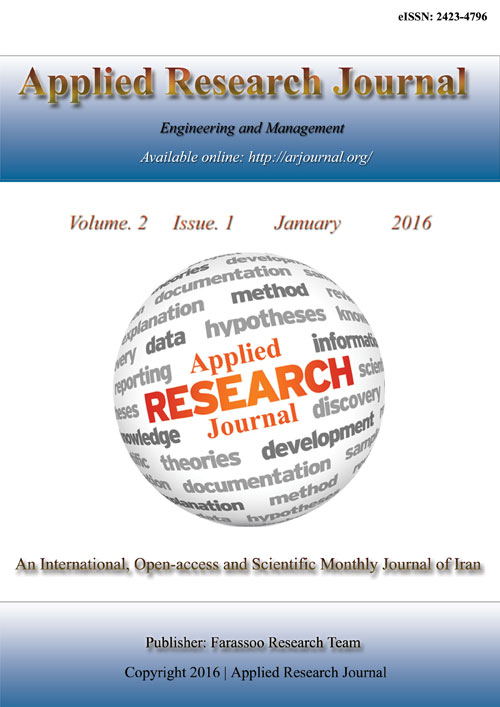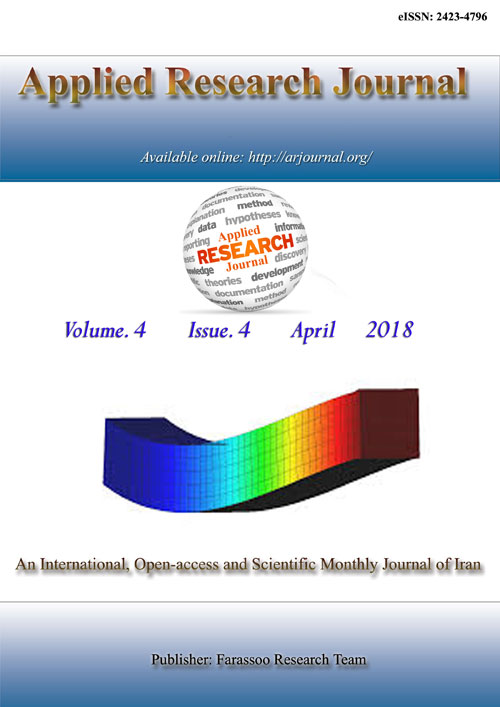فهرست مطالب

Applied Research Journal
Volume:2 Issue: 1, Jan 2016
- تاریخ انتشار: 1394/10/26
- تعداد عناوین: 4
-
Pages 1-9The dynamic and accurate forecasting of monthly streamflow processes of a river are important in the management of extreme events such as floods and drought, optimal design of water storage structures and drainage network. Many Rivers are selected in this study; White Nile; Blue Nile; Atbara River and main Nile. This paper aims to recommend the best linear stochastic model in forecasting monthly streamflow in rivers. Two commonly hydrologic models; the deasonalized autoregressive moving average (DARMA) models and seasonal autoregressive integrated moving average (SARIMA) models are selected for modeling monthly streamflow in all Rivers in the study area. Two different types of monthly streamflow data (deseasonalized data and differenced data) were used to develop time series model using previous flow conditions as predictors.The one month ahead forecasting performances of all models for predicted period were compared. The comparison of model forecasting performance was conduct based upon graphical and numerical criteria. The result indicate that deasonalized autoregressive moving average (DARMA) models perform better than seasonal autoregressive integrated moving average (SARIMA) models for monthly streamflow in Rivers.Keywords: Monthly stream flow, River Nile, DARMA model, SARIMA model, stochastic model
-
Pages 10-18Roller compacted asphalt concrete slab samples with dimension of (300x400) mm, 60 mm thick were prepared in the laboratory under controlled conditions. Forty-eight core specimens with diameter of 100mm and 60mm thick have been obtained from Roller compacted slabs, and were implemented for resilient modulus (Mr) and rutting resistance determination under indirect tensile repeated loading (ITRL), with constant stress level. Half of the cores were directly tested at 25° C and 40° C (unconditioned). The other half of cores were conditioned by placing in volumetric flask 4000-ml filled with water at room temperature of 25˚C, then a vacuum of (3.74 kPa) was applied for 10 minutes to obtain 80 % degree level of saturation. The specimens were then placed in deep freeze at (-18˚C) for (16) hours. The frozen specimens were then moved to a water bath for (24) hours at (60ºC). Then they were placed in a water bath at (25ºC) or 40 ºC for 1 hour, and they were tested for ITRL (conditioned). It was concluded that the change in permanent deformation at Conditioned test as compared to unconditioned test was (88.19%, 88.01% and 108.09%) at 25˚C, while at 40˚C it was (20.89%, -1.14% and 19.46%) for recycled mixtures with Soft Asphalt cement (Ac), (Soft Ac + Silica Fumes) and (Soft Ac+ Fly ash) respectively. The reduction in (Mr) at Conditioned test as compared to Unconditioned test was (-3.7%, -16.67% and -7.69%) at 25˚C, while at 40˚C, it was (-6.25%, -14.29% and -7.14%) for recycled mixtures with (Soft Ac), (Soft Ac + Silica Fumes) and (Soft Ac + Fly ash) respectively.Keywords: Asphalt concrete, repeated indirect tensile test, rutting, resilient modulus, recycling
-
Pages 19-26The facilities used for measuring and recording of global solar radiation are not easily available due to the cost and techniques involved. The limited effort of the measurement indicates that there is a need to establish theoretical methods for estimating solar radiation based on the available meteorological data. In this work, the measured data of solar radiation on a horizontal surface and number of sunshine hours for Maiduguri for 15 years (1996-2010) were collected and analyzed, regression constants for the first order Angstrom-type correlations for Maiduguri were calculated using regression analysis. The monthly calculated clearness index and monthly sunshine duration were correlated and modeled using four existing sunshine-based models which are linear, quadratic, exponential and power equations. The results of the four models were compared. It was observed that the quadratic model performed better in terms of coefficient of determination than the other three models. A modified form of Ogelman model has therefore been recommended in estimating the monthly average daily global solar radiation for Maiduguri.Keywords: Global solar radiation, Maiduguri, Sunshine
-
Pages 27-40Collapsible soil is broadly classified as a loose and cemented soil with low moisture content that is susceptible to a large and sudden reduction in volume upon wetting, with no increase in vertical stress. The rapid collapse of soils damages the structures which have built on such soils. Collapsible soils are one of many problematic soils. Many foundation failure problems that occurred in the world are associated with percolation of water; the change in the degree of saturation can affect the stability of these soils and may encounter large volumetric change. In this study, the derivation of new equations describing the settlement rate of collapsible soil upon inundation with no external loading; with varying degrees of saturations, simulating capillary water rise from the subsurface water Table. The theoretical equations were verified through a series of experimental tests where the modified odometer apparatus was used.Keywords: Collapsible Soil, Collapse Rate, Unsaturated soil, Tensiometer, Settlement


